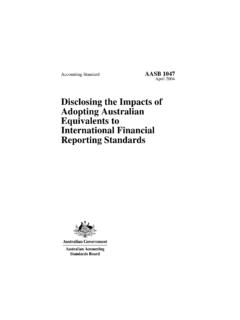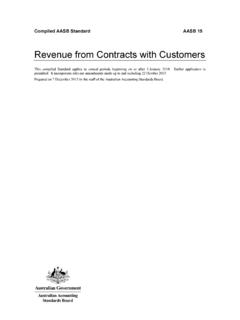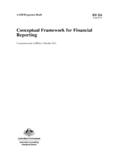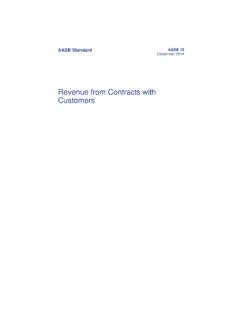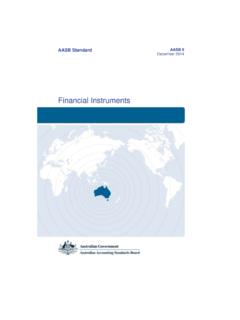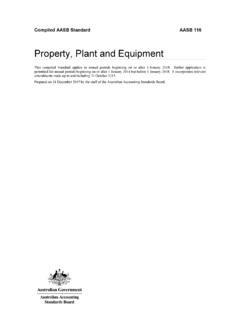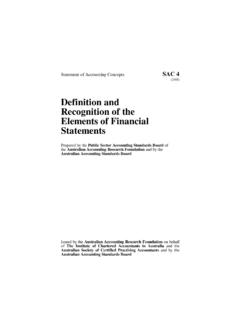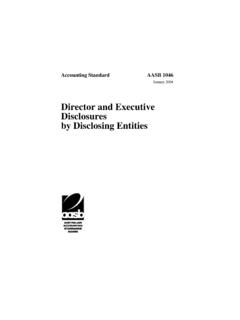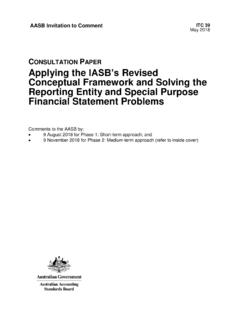Transcription of AASB 1060 Key Facts (03/20)
1 Key Facts : AASB 1060 General Purpose Financial Statements Simplified Disclosures for For-Profit and Not-for-Profit Entities What Who When? Why did we develop a new Standard? What? A new stand-alone disclosure standard to Supports the removal of special purpose financial reporting replace the current reduced disclosure requirements proposed by AASB 2020-2 Amendments to Australian (RDR) framework. Accounting Standards Removal of Special Purpose Who will this apply to? All tier 2 for-profit and not- Financial Statements for Certain For-Profit Private Sector for-profit (NFP) entities. entities. Note: for NFP and public sector entities, this is only Addresses concerns raised in relation to the current Tier 2.
2 An interim measure while the financial reporting disclosure requirements. frameworks for these sectors are finalised. When? Mandatory from 1 July 2021, with early How was the new standard developed? application permitted. IFRS for SMEs disclosures used as a starting point. What does this mean for you? No presentation differences to Tier 1. Disclosures that relate to recognition & measurement Reductions in disclosure compared to current RDR options/treatments which are not available in full IFRS have (see table below). been removed. An increase in disclosures compared to Special Disclosures adapted where the recognition and Purpose Financial Statements, particularly related measurement principles are significantly different, or for parties, financial instruments and tax.
3 Topics not addressed. An option not to present a statement of changes in Disclosures added for topics that have not been addressed equity under certain circumstances. or that are a matter of public interest, or where Australian- Some additional disclosures not currently required. specific issues. Disclosures removed from RDR1. Topic Details of removed disclosures Primary financial Option to omit the statement of changes in equity in certain circumstances and present statement statements of income and retained earnings instead. Revenue Separate disclosure of revenue from contracts with customers from other revenue and impairment losses on receivables or contract assets;. information about assets recognised from costs to obtain or fulfil a contract with a customer.
4 Use of practical expedients; and Disclosure of specific judgements made (however may be caught by general requirement to disclose significant judgements). Other income and Individually material income or expense items (however separate disclosure of each material class expense of similar items is still required); and Certain gains and losses relating to reclassified financial assets. Financial assets Detailed disclosures about measurement bases (accounting policy still required);. and financial information about reclassified financial assets;. liabilities Loss allowance recognised in relation to financial assets at fair value through other comprehensive income;. Compound financial instruments with multiple embedded derivatives.
5 Transferred assets not derecognised in their entirety (less detail); and Transferred assets derecognised in their entirety (no disclosures). Hedging Overall less details required, but some additional disclosures (see below). Lessee Amounts recognised by a lessee (only required to disclose lease payments recognised as disclosures expense, and additions to and depreciation of right-of-use assets);. Additional qualitative and quantitative information (only required to disclose general description of leasing arrangements);. Application of recognition exemption for short-term and low value leases; and Additional disclosures relating to variable lease payments, extension options or termination options, and residual value guarantees.
6 Lessor Disclosures for finance and operating leases (no disclosure of selling profit or loss for finance disclosures leases and lease income for operating leases); and information about how lessor manages risks associated with rights retained. This AASB key Facts summary has been prepared by the staff of the AASB for information purposes only and is not authoritative. This document has not been reviewed or approved by the AASB. Australian Accounting Standards Board 2020. Disclosures removed from RDR (continued). Topic Details Impairment Impairment losses & reversals (no separate disclosure of impairment losses & reversals for revalued assets); and Recoverable amount of individual assets or cash-generating unit (CGU) for which an impairment loss has been recognised.
7 Share capital Reconciliation of shares not required for comparative period. Business Less details required about the acquired entity/operation. combinations Discontinued Tax expense relating to discontinued operations; and operations Cash flows of discontinued operations. Interests in other Judgements and assumptions made disclose only if control with <50% of voting rights (but may entities be caught by general requirement to disclose significant judgements);. Simplified disclosures about the composition of the group;. Significant restrictions (no disclosure of carrying amounts of assets and liabilities to which the restrictions apply);. Risks associated with interests in consolidated entities;. Investments entities and interests in unconsolidated subsidiaries; and information about interests in joint arrangements and associates (no disclosure of names, ownership interest etc.)
8 New disclosures added as a result of the IFRS for SMEs Topic Details General information information about domicile and legal form etc. Hedging disclosures For cash flow hedges and hedges of a net investment in a foreign operation the periods when the cash flows are expected to occur and when they are expected to affect profit or loss. Investments in For associates accounted for at cost: amount of dividends and other distributions recognised as associates and joint income; and ventures For equity-accounted associates and joint ventures: separate disclosure of share of discontinued operations Business Qualitative description of factors that make up goodwill. combinations Leases Lessees: maturity analysis of future lease payments.
9 Lessors with operating leases: variable lease payments recognised as income; and Lessors with finance leases: loss allowance for lease receivables. Employee benefits For defined benefit plans: amounts recognised in profit or loss as expense, actual return on plan assets; and For termination benefits: information about the nature of the benefits, amounts of obligation and extent of funding1. Related parties Disclosure of parent-subsidiary relationship by government-related entities. First-time Explanation of how transition has affected reported amounts, description of the nature of each adoption disclosures change in accounting policy, reconciliation of profit or loss with separate identification of errors and, where applicable, a statement that the entity did not present financial statements for previous periods; and But note disclosure relief provided by AASB 2020-2.
10 1 Red font indicates disclosures that are not required under full IFRS/Australian Accounting Standards New disclosures added for other reasons Topic Reason Audit fees To assist in improving auditor independence and accountability, thereby increasing users'. confidence in the quality of companies' financial reports. Imputation credits To provide useful information to investors about dividend and future earnings potential. 2. Amendments resulting from feedback to ED 295. ED 295 General Purpose Financial Statements Simplified Disclosures for For-Profit and Not-for-Profit Tier 2 Entities, was issued in August 2019, together with ED 297 Removal of Special Purpose Financial Statements for Certain For- Profit Private Sector Entities, with comment period ended on 30 November 2019.
